PLAY WITH HOPPER
Dr. D. Creative Scriptwriting to Fine Art - Workshop
Planning for Academic Rigor
Introduction to rigorous task:
The goal is to compose … EXCEPTIONALLY BAD DIALOGUES FOR GIVEN SCENE! Well… not just a bad, but THE WORST EVER! I am delighted to present to you the works of Edward Hopper, which will serve as the basis for our scenes and characters. You and your teammate are tasked with writing a total of 10 lines of dialogue. However, there are a few additional guidelines to follow. Each team will contribute one line at a time to each other's scene, based on the provided script combination. Please include your scene identifiers, such as "A", "B", "C", and your character names in your final submission. To ensure your work is formatted correctly, please refer to the provided example.
Additionally, in your work, please
adhere to the following guidelines:
For LINE 3:
The question posed must be
of a personal nature.
For LINE 5:
A reference to any animal must be included.
For LINE 7: The dialogue must involve the sharing of a secret.
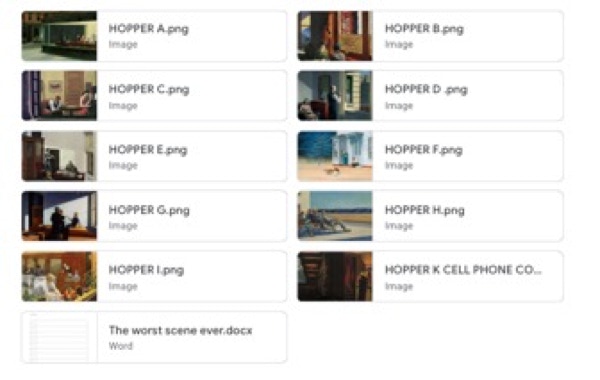
Once the dialogues have been assigned to their respective scenes, students will be given parts and will perform all the mysterious scenes in front of the class. This will be the first time that students will encounter all the scenes.
After the performances, students will use the "Turn and Talk" method to analyze all the scenes that have been uploaded to the online assignment.
Finally, students will vote for the worst scene ever using a Google Form that was prepared earlier by the teacher. However, there is some confusion about whether students should vote for the scene they liked the least or the one they liked the most out of the 10 scenes. Unfortunately, no instructions were provided to clarify this matter.
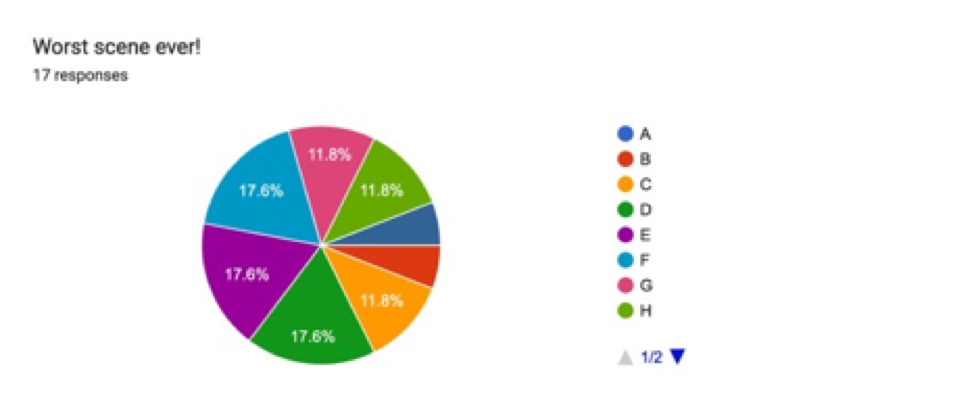
Following the publication of the voting results (which can be found above), I prompted students to provide a more in-depth explanation in 2-5 lines as to why they believe the majority of students selected scenes D, E, and F as the worst scenes ever. I encouraged them to use at least one piece of evidence from the selected scenes to support their reasoning.
Additionally, I rewarded students for their thoughtful answers and posed follow-up questions to further the discussion.
Ambiguity of Task:
Students are expected to integrate and evaluate information from multiple sources presented in various media or formats, as well as in words, to address a question or solve a problem (CCLS ELA Literacy Anchor Reading). They are also required to analyze and evaluate the effectiveness of the structure used by an author in their exposition or argument, including whether the structure makes points clear, convincing, and engaging.
In this project, students have learned to write dialogues for scenes painted by Edward Hopper. However, the goal was to write the worst dialogue ever. To achieve this, students needed to first understand what constitutes a proper dialogue and then create the opposite. No additional context about the scene was provided to make the task more challenging.
To further complicate the workflow, the teacher requested specific tasks for lines 3, 5, and 7, requiring the mention of personal, animal, and secret elements by the characters in the dialogues. Students were also asked to use advanced temporal manipulation and continuity techniques to create a flow of possible conversation characters painting by Edward Hopper. Moreover, they were exposed to Hopper's painting technique and style, which is closely connected to characteristic film frames.
Students worked in culturally diverse tandems to bring different perspectives to the creative process. They were encouraged to add personal interpretation and stylistic choices while creating dialogues appropriate to the task, purpose, and audience. However, they had to use valid reasoning and relevant and sufficient evidence, such as well-chosen details, to create dialogues with opposite values.
The task aligns with the following standards: ELA 9-10W3b, CCLS Literacy Writing, Reading, and Visual Arts. It could also be part of CCLS Math Anchor by making sense of the problem and persevering in solving them, using appropriate tools strategically, looking for and making use of structure. Working in Google Classroom, students also accessed, generated, processed, and transferred information using appropriate technologies.
To differentiate and meet the needs of individual learners, instructions were presented in auditory and visual means, and individual meetings were held to extend thinking. The length of time students could complete the task was varied to provide additional support for struggling teams and encourage advanced learners to find greater depth. Proper space was provided for all groups to work without distraction while being challenging.
Verbal instructions were also prepared in Google Classroom to save more time for students' work. The teacher-to-student ratio was 1:4, stretching cognitive work and work distribution, and working together as soon as they were ready.
Rigorous Task Materials:
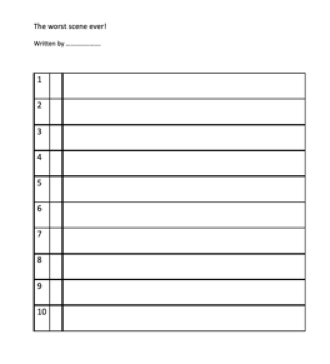
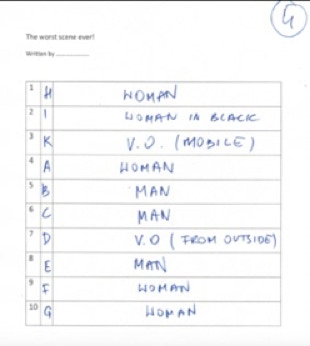
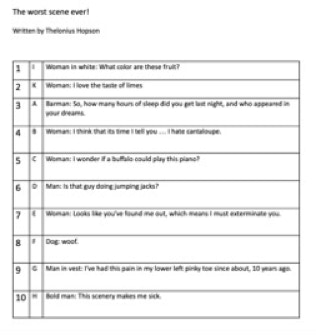
Rubric

Achievement
9 out of 10 teams successfully submitted their dialogues. One team, however, lost their assignment during the transfer to Google Classroom, but they were able to explain the situation to me, and I was able to see their work in progress, so I excused them.
Additionally, one team decided to split up, with students opting to work independently, which was evident in the final outcome.
One dialogue rubric had missing text, and another had two dialogues per character. All submitted materials had punctuation, spelling, and grammar errors, and students were asked to rewrite them for the final submission, unless the errors were intentional.
The student's performance was uploaded to Google Classroom, along with their grades, so they were able to see how their performance compared to the average.
Analysis
Students strive to produce the best outcome, but in this case, the best must be the worst. To achieve this, students must first create a positive version of the dialogue using their personal strengths, and then reimagine it into the opposite.
Students were grouped in pairs of stronger and weaker learners, with advanced students taking on leadership roles within the class, explaining and demonstrating proper techniques.
It is crucial that all students upload their work, as the whole class will be held back from success if any team fails to participate partially in all 10 projects.
Lastly, it is important to note that even when creating the worst dialogue ever, proper grammar rules must still be followed. (Format Matters.)